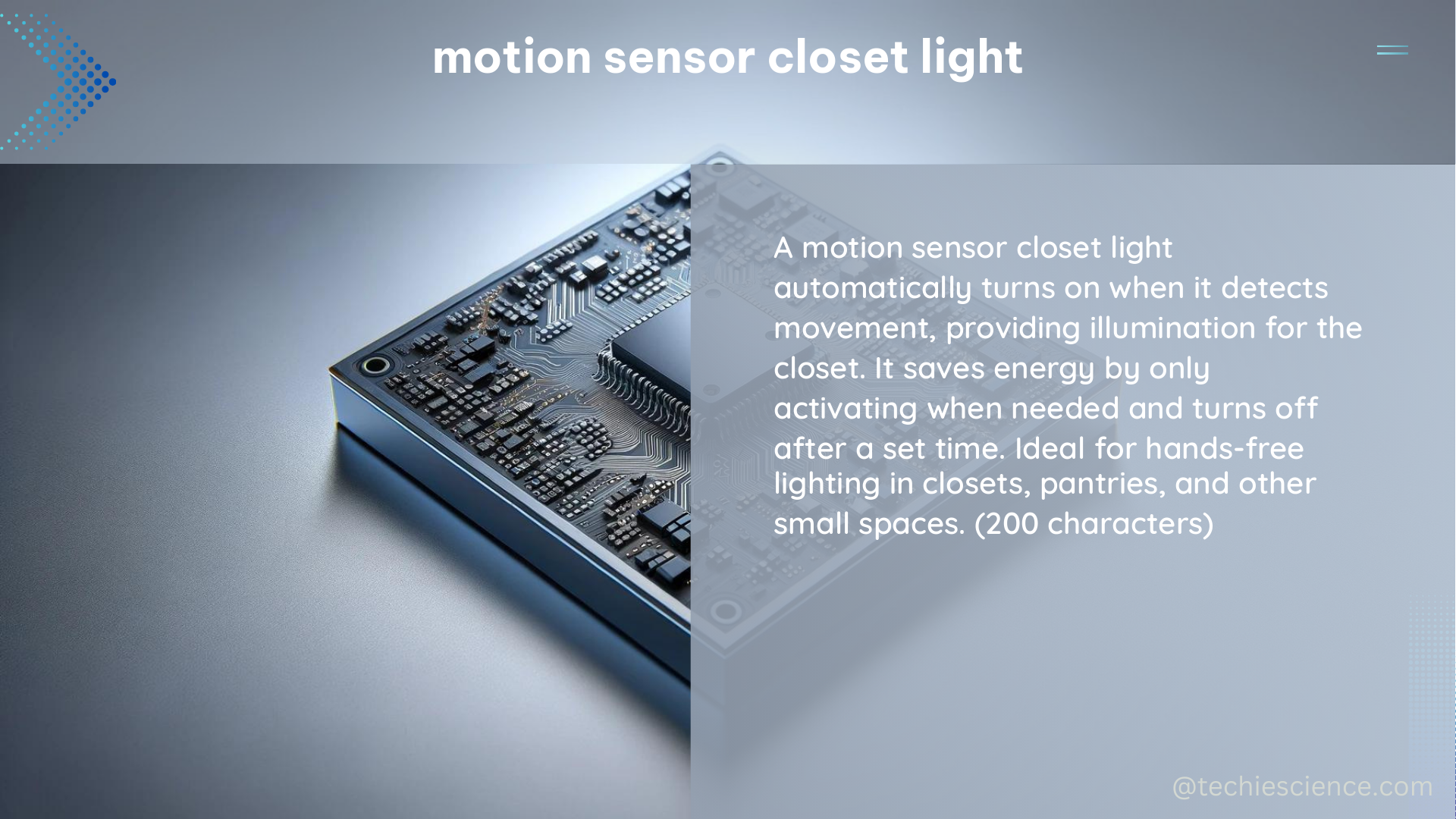Motion sensor closet lights are a game-changer when it comes to energy-efficient and convenient lighting solutions for your home. These advanced systems automatically turn on and off in response to movement within a closet space, providing illumination only when needed and reducing energy consumption significantly. In this comprehensive guide, we’ll dive deep into the technical specifications, installation considerations, and market-leading options to help you make an informed decision for your closet lighting needs.
Understanding the Anatomy of Motion Sensor Closet Lights
At the core of a motion sensor closet light system are three key components: the light fixture, the motion sensor, and the control module. The light fixture is responsible for providing the illumination, typically using energy-efficient LED technology. The motion sensor is the brains of the operation, detecting movement within the closet and sending a signal to the control module.
The control module is the central processing unit that receives the input from the motion sensor and activates the light fixture accordingly. It also manages the timing of the light, ensuring that it stays on for a predetermined duration after the last detected motion.
Sensor Technology and Detection Range

The motion sensor is the critical component that sets motion sensor closet lights apart from traditional lighting solutions. These sensors utilize a variety of technologies, including passive infrared (PIR), microwave, and dual-technology sensors that combine PIR and microwave.
The detection range of the motion sensor is a crucial specification to consider. This refers to the maximum distance at which the sensor can reliably detect movement and trigger the light. Longer detection ranges, such as the 24-foot range of the Lutron Maestro Motion Sensor Closet Light, provide greater convenience and coverage, ensuring the light turns on even when you’re at the far end of the closet.
Illumination and Lumen Output
The light output of a motion sensor closet light is measured in lumens, which is a unit that quantifies the total amount of visible light emitted by a source. Higher lumen outputs, like the 500 lumens of the LEONLITE Motion Sensor Closet Light, can provide brighter and more comprehensive illumination, particularly in larger closet spaces.
It’s important to consider the specific lighting needs of your closet when selecting a motion sensor light. Factors such as the size of the closet, the presence of shelves or hanging clothes, and personal preferences for brightness can all influence the optimal lumen output.
Power Source and Battery Life
Motion sensor closet lights can be powered in different ways, with some models requiring hardwiring into your home’s electrical system, while others are battery-powered or offer both options.
Battery-powered models, like the Enerlites Motion Sensor Closet Light, offer the convenience of easy installation and portability, but their battery life is a crucial consideration. Look for models with extended battery life, such as the Lutron Maestro Motion Sensor Closet Light, which can last up to 10 years on a single set of batteries.
Installation Considerations
The installation process for motion sensor closet lights can vary depending on the specific model and power source. Hardwired models, such as the Lutron Maestro, require more involved electrical work and may necessitate the assistance of a licensed electrician.
On the other hand, battery-powered or wireless models, like the Enerlites and LEONLITE options, often offer a more straightforward DIY installation process. These models typically involve mounting the light fixture and motion sensor, and may even include adhesive or magnetic mounting options for easy, tool-free installation.
Market-Leading Motion Sensor Closet Light Options
To give you a comprehensive understanding of the available options, let’s take a closer look at three market-leading motion sensor closet lights:
- Lutron Maestro Motion Sensor Closet Light
- Detection range: up to 24 feet
- Light output: 450 lumens
- Battery life: up to 10 years
-
Installation: hardwired
-
Enerlites Motion Sensor Closet Light
- Detection range: up to 10 feet
- Light output: 300 lumens
- Battery life: up to 1 year
-
Installation: battery-powered or hardwired
-
LEONLITE Motion Sensor Closet Light
- Detection range: up to 16 feet
- Light output: 500 lumens
- Battery life: up to 1 year
- Installation: battery-powered or hardwired
These models represent a diverse range of options, catering to different closet sizes, lighting preferences, and installation requirements. By understanding the technical specifications of each, you can make an informed decision that best suits your needs.
Conclusion
Motion sensor closet lights are a smart and energy-efficient solution for illuminating your closet spaces. By delving into the technical details, from sensor technology and detection range to illumination and power source, this comprehensive guide has provided you with the knowledge to make an informed decision and select the perfect motion sensor closet light for your home.
Remember, when it comes to motion sensor closet lights, the devil is in the details. By considering factors like lumen output, battery life, and installation requirements, you can ensure that your chosen solution not only meets your lighting needs but also provides long-lasting, convenient, and energy-efficient performance.
So, whether you’re looking to upgrade an existing closet or planning a new home project, this guide has equipped you with the necessary information to navigate the world of motion sensor closet lights and make the best choice for your space.
References:
- Transit Asset Management Systems Handbook. (2020). Federal Transit Administration.
- Light effects in the design process. (2014). UCL Discovery.
- LANL Sustainable Design Guide. (2002). Los Alamos National Laboratory.

The lambdageeks.com Core SME Team is a group of experienced subject matter experts from diverse scientific and technical fields including Physics, Chemistry, Technology,Electronics & Electrical Engineering, Automotive, Mechanical Engineering. Our team collaborates to create high-quality, well-researched articles on a wide range of science and technology topics for the lambdageeks.com website.
All Our Senior SME are having more than 7 Years of experience in the respective fields . They are either Working Industry Professionals or assocaited With different Universities. Refer Our Authors Page to get to know About our Core SMEs.